warning YAMAHA YBR125 2004 Owners Manual
[x] Cancel search | Manufacturer: YAMAHA, Model Year: 2004, Model line: YBR125, Model: YAMAHA YBR125 2004Pages: 83, PDF Size: 3.16 MB
Page 5 of 83
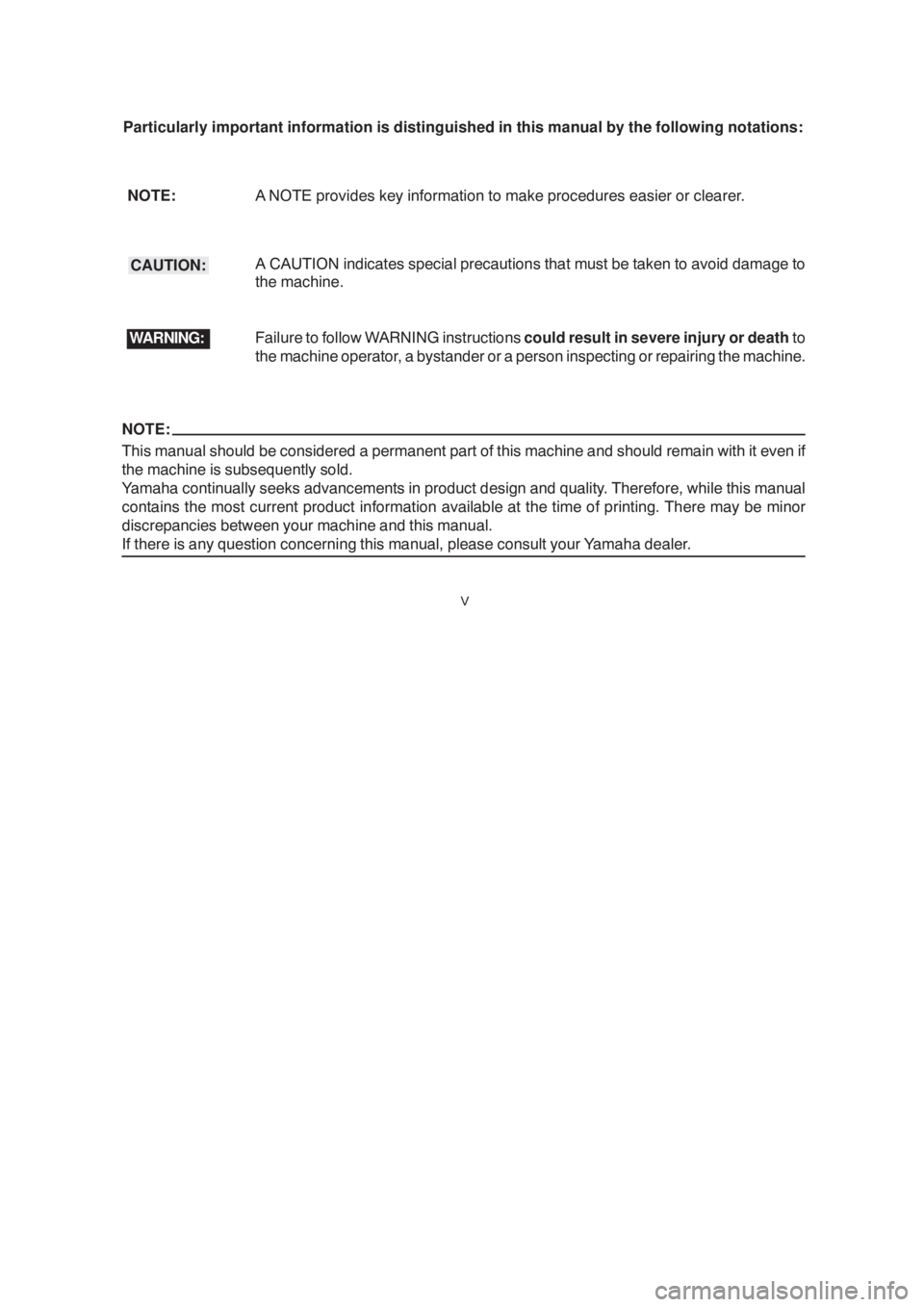
V
Particularly important information is distinguished in this manual by the following notations:
NOTE:A NOTE provides key information to make procedures easier or clearer.
A CAUTION indicates special precautions that must be taken to avoid damage to
the machine.
Failure to follow WARNING instructions could result in severe injury or death to
the machine operator, a bystander or a person inspecting or repairing the machine.
CAUTION:
WARNING:
NOTE:
This manual should be considered a permanent part of this machine and should remain with it even if
the machine is subsequently sold.
Yamaha continually seeks advancements in product design and quality. Therefore, while this manual
contains the most current product information available at the time of printing. There may be minor
discrepancies between your machine and this manual.
If there is any question concerning this manual, please consult your Yamaha dealer.
V
Particularly important information is distinguished in this manual by the following notations:
NOTE:A NOTE provides key information to make procedures easier or clearer.
A CAUTION indicates special precautions that must be taken to avoid damage to
the machine.
Failure to follow WARNING instructions could result in severe injury or death to
the machine operator, a bystander or a person inspecting or repairing the machine.
CAUTION:
WARNING:
NOTE:
This manual should be considered a permanent part of this machine and should remain with it even if
the machine is subsequently sold.
Yamaha continually seeks advancements in product design and quality. Therefore, while this manual
contains the most current product information available at the time of printing. There may be minor
discrepancies between your machine and this manual.
If there is any question concerning this manual, please consult your Yamaha dealer.
Page 6 of 83

VI
PLEASE READ THIS MANUAL CAREFULLY AND COMPLETELY BEFORE OPERATING THIS MACHINE. DO NOT
ATTEMPT TO OPERATE THIS MOTORCYCLE UNTIL YOU HAVE ATTAINED A SATISFACTORY KNOWLEDGE OF
ITS CONTROLS AND OPERATING FEATURES AND UNTIL YOU HAVE BEEN TRAINED IN SAFE AND PROPER
RIDING TECHNIQUES. REGULAR INSPECTIONS AND CAREFUL MAINTENANCE, ALONG WITH GOOD RIDING
SKILLS WILL ENSURE THAT YOU SAFELY ENJOY THE CAPABILITIES AND THE RELIABILITY OF THIS
MOTORCYCLE.
WARNING:
VI
PLEASE READ THIS MANUAL CAREFULLY AND COMPLETELY BEFORE OPERATING THIS MACHINE. DO NOT
ATTEMPT TO OPERATE THIS MOTORCYCLE UNTIL YOU HAVE ATTAINED A SATISFACTORY KNOWLEDGE OF
ITS CONTROLS AND OPERATING FEATURES AND UNTIL YOU HAVE BEEN TRAINED IN SAFE AND PROPER
RIDING TECHNIQUES. REGULAR INSPECTIONS AND CAREFUL MAINTENANCE, ALONG WITH GOOD RIDING
SKILLS WILL ENSURE THAT YOU SAFELY ENJOY THE CAPABILITIES AND THE RELIABILITY OF THIS
MOTORCYCLE.
WARNING:
Page 7 of 83
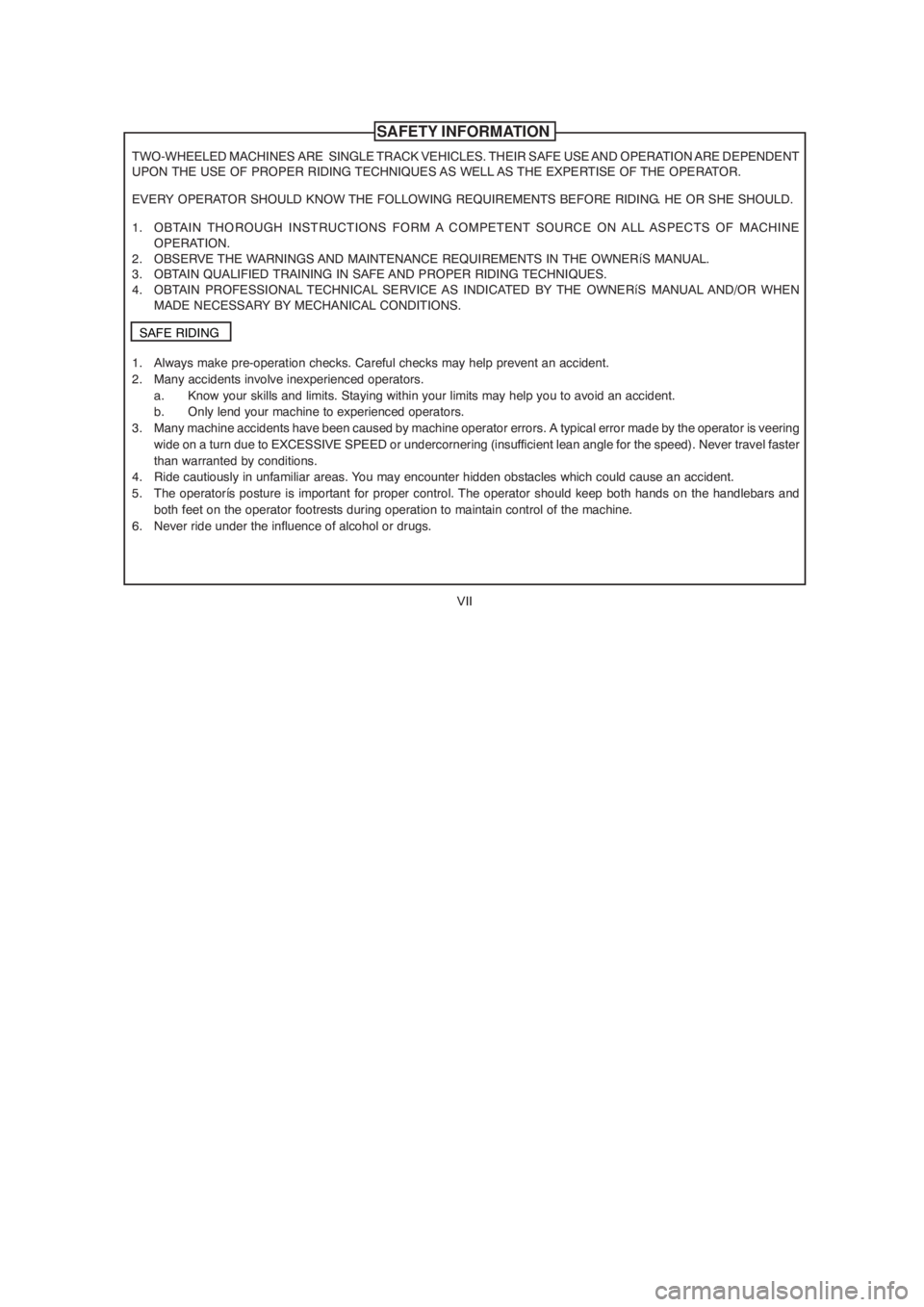
VII
TWO-WHEELED MACHINES ARE SINGLE TRACK VEHICLES. THEIR SAFE USE AND OPERATION ARE DEPENDENT
UPON THE USE OF PROPER RIDING TECHNIQUES AS WELL AS THE EXPERTISE OF THE OPERATOR.
EVERY OPERATOR SHOULD KNOW THE FOLLOWING REQUIREMENTS BEFORE RIDING. HE OR SHE SHOULD.
1. OBTAIN THOROUGH INSTRUCTIONS FORM A COMPETENT SOURCE ON ALL ASPECTS OF MACHINE
OPERATION.
2. OBSERVE THE WARNINGS AND MAINTENANCE REQUIREMENTS IN THE OWNERíS MANUAL.
3. OBTAIN QUALIFIED TRAINING IN SAFE AND PROPER RIDING TECHNIQUES.
4. OBTAIN PROFESSIONAL TECHNICAL SERVICE AS INDICATED BY THE OWNERíS MANUAL AND/OR WHEN
MADE NECESSARY BY MECHANICAL CONDITIONS.
SAFE RIDING
1. Always make pre-operation checks. Careful checks may help prevent an accident.
2. Many accidents involve inexperienced operators.
a. Know your skills and limits. Staying within your limits may help you to avoid an accident.
b. Only lend your machine to experienced operators.
3. Many machine accidents have been caused by machine operator errors. A typical error made by the operator is veering
wide on a turn due to EXCESSIVE SPEED or undercornering (insufficient lean angle for the speed). Never travel faster
than warranted by conditions.
4. Ride cautiously in unfamiliar areas. You may encounter hidden obstacles which could cause an accident.
5. The operatorís posture is important for proper control. The operator should keep both hands on the handlebars and
both feet on the operator footrests during operation to maintain control of the machine.
6. Never ride under the influence of alcohol or drugs.
SAFETY INFORMATION
VII
TWO-WHEELED MACHINES ARE SINGLE TRACK VEHICLES. THEIR SAFE USE AND OPERATION ARE DEPENDENT
UPON THE USE OF PROPER RIDING TECHNIQUES AS WELL AS THE EXPERTISE OF THE OPERATOR.
EVERY OPERATOR SHOULD KNOW THE FOLLOWING REQUIREMENTS BEFORE RIDING. HE OR SHE SHOULD.
1. OBTAIN THOROUGH INSTRUCTIONS FORM A COMPETENT SOURCE ON ALL ASPECTS OF MACHINE
OPERATION.
2. OBSERVE THE WARNINGS AND MAINTENANCE REQUIREMENTS IN THE OWNERíS MANUAL.
3. OBTAIN QUALIFIED TRAINING IN SAFE AND PROPER RIDING TECHNIQUES.
4. OBTAIN PROFESSIONAL TECHNICAL SERVICE AS INDICATED BY THE OWNERíS MANUAL AND/OR WHEN
MADE NECESSARY BY MECHANICAL CONDITIONS.
SAFE RIDING
1. Always make pre-operation checks. Careful checks may help prevent an accident.
2. Many accidents involve inexperienced operators.
a. Know your skills and limits. Staying within your limits may help you to avoid an accident.
b. Only lend your machine to experienced operators.
3. Many machine accidents have been caused by machine operator errors. A typical error made by the operator is veering
wide on a turn due to EXCESSIVE SPEED or undercornering (insufficient lean angle for the speed). Never travel faster
than warranted by conditions.
4. Ride cautiously in unfamiliar areas. You may encounter hidden obstacles which could cause an accident.
5. The operatorís posture is important for proper control. The operator should keep both hands on the handlebars and
both feet on the operator footrests during operation to maintain control of the machine.
6. Never ride under the influence of alcohol or drugs.
SAFETY INFORMATION
Page 22 of 83
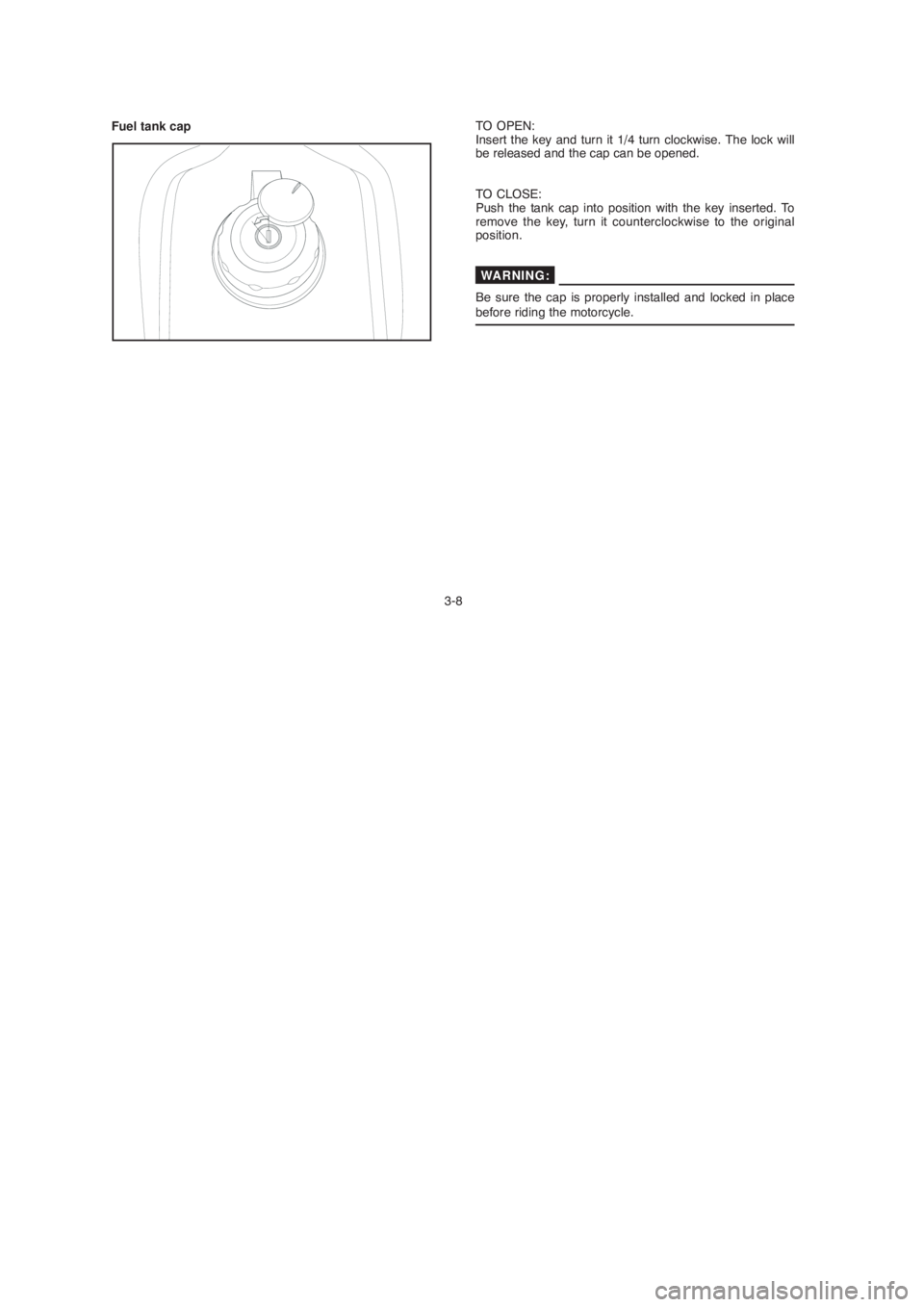
Fuel tank cap
3-8TO OPEN:
Insert the key and turn it 1/4 turn clockwise. The lock will
be released and the cap can be opened.
TO CLOSE:
Push the tank cap into position with the key inserted. To
remove the key, turn it counterclockwise to the original
position.
Be sure the cap is properly installed and locked in place
before riding the motorcycle.
WARNING:
Fuel tank cap
3-8TO OPEN:
Insert the key and turn it 1/4 turn clockwise. The lock will
be released and the cap can be opened.
TO CLOSE:
Push the tank cap into position with the key inserted. To
remove the key, turn it counterclockwise to the original
position.
Be sure the cap is properly installed and locked in place
before riding the motorcycle.
WARNING:
Page 25 of 83
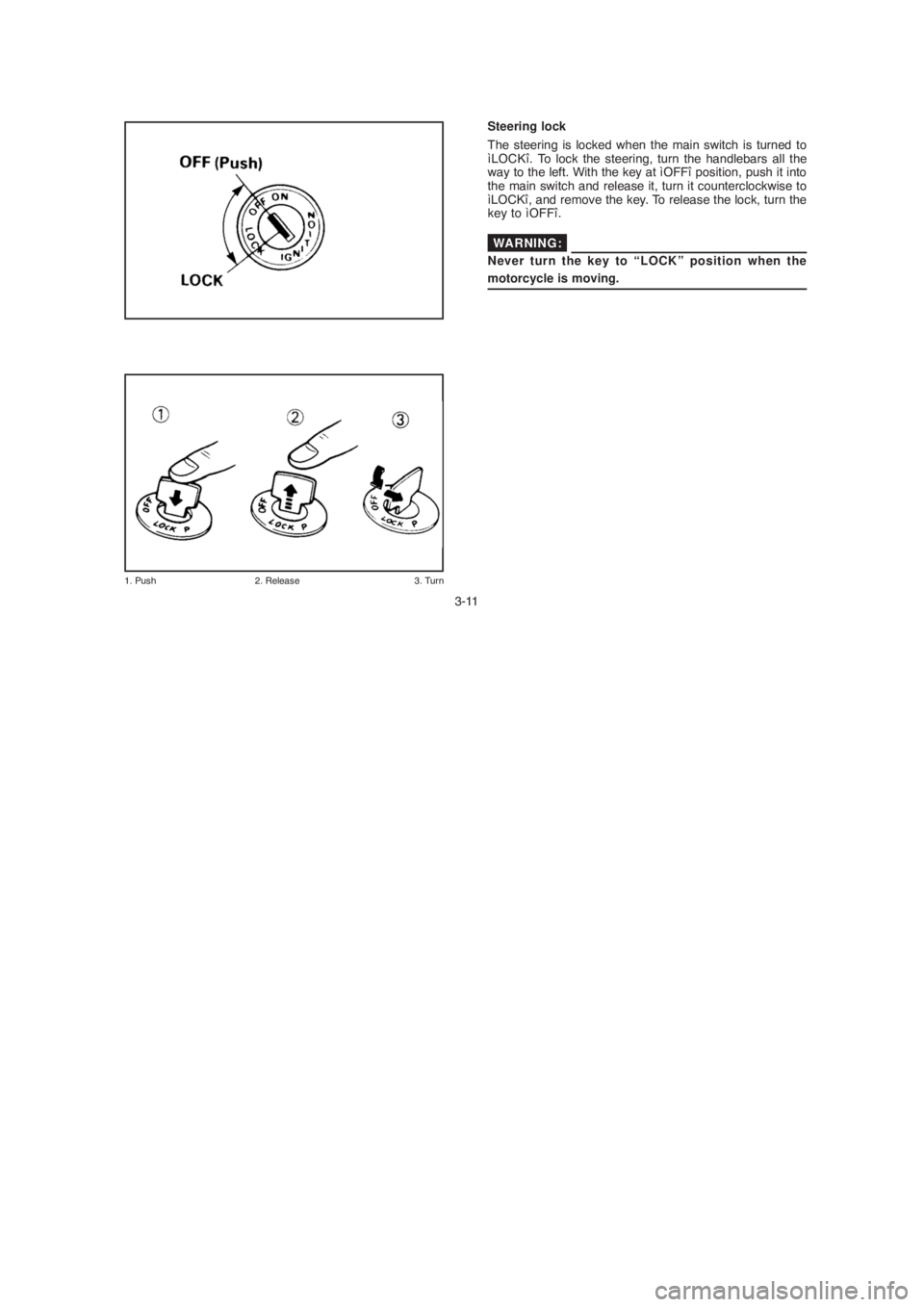
3-11
1. Push 2. Release 3. Turn
LOCK OFF (PUSH)
Steering lock
The steering is locked when the main switch is turned to
ìLOCKî. To lock the steering, turn the handlebars all the
way to the left. With the key at ìOFFî position, push it into
the main switch and release it, turn it counterclockwise to
ìLOCKî, and remove the key. To release the lock, turn the
key to ìOFFî.
Never turn the key to “LOCK” position when the
motorcycle is moving.
WARNING:
3-11
1. Push 2. Release 3. Turn
LOCK OFF (PUSH)
Steering lock
The steering is locked when the main switch is turned to
ìLOCKî. To lock the steering, turn the handlebars all the
way to the left. With the key at ìOFFî position, push it into
the main switch and release it, turn it counterclockwise to
ìLOCKî, and remove the key. To release the lock, turn the
key to ìOFFî.
Never turn the key to “LOCK” position when the
motorcycle is moving.
WARNING:
Page 30 of 83

4-2 NOTE:
Pre-operation checks should be made each time the motorcycle is used. Such an inspection can be thoroughly accomplished
in a very short time; and the added safety it assures is more than worth the time involved. If any maintenance service or
adjustment is needed, consult the chart above to refer to the pages in which the service or adjustment is described.
1. The engine, exhaust pipe, and muffler will be very hot after the engine has been run.
Be careful not to touch them or to allow any clothing item to contact them during inspection or repair.
2. If any item is not working properly, have it inspected and repaired before operating the motorcycle.
ITEMROUTINE
PAGE
Sidestand
Fittings / FastenersCheck all chassi fittings and fasteners.
Tighten / Adjust, if necessary
Check fuel level / top up as required.
Fuel tank
Lights, signals and switches
BatteryCheck electrolyte level.
Replenish with ìdistilled waterî if necessary.6-22
4-6 , 6-5
4-6 , 6-28 ~ 6-30
6-25 ~ 6-276-22
4-7
Check for proper operation
Front brake and clutch
lever pivotsCheck for smooth operation.
Lubricate if necessary
Check for smooth operation.
Lubricate if necessary
6-22 Check for smooth operation.
Lubricate if necessary Rear brake and shift pedal
shafts
WARNING:
4-2 NOTE:
Pre-operation checks should be made each time the motorcycle is used. Such an inspection can be thoroughly accomplished
in a very short time; and the added safety it assures is more than worth the time involved. If any maintenance service or
adjustment is needed, consult the chart above to refer to the pages in which the service or adjustment is described.
1. The engine, exhaust pipe, and muffler will be very hot after the engine has been run.
Be careful not to touch them or to allow any clothing item to contact them during inspection or repair.
2. If any item is not working properly, have it inspected and repaired before operating the motorcycle.
ITEMROUTINE
PAGE
Sidestand
Fittings / FastenersCheck all chassi fittings and fasteners.
Tighten / Adjust, if necessary
Check fuel level / top up as required.
Fuel tank
Lights, signals and switches
BatteryCheck electrolyte level.
Replenish with ìdistilled waterî if necessary.6-22
4-6 , 6-5
4-6 , 6-28 ~ 6-30
6-25 ~ 6-276-22
4-7
Check for proper operation
Front brake and clutch
lever pivotsCheck for smooth operation.
Lubricate if necessary
Check for smooth operation.
Lubricate if necessary
6-22 Check for smooth operation.
Lubricate if necessary Rear brake and shift pedal
shafts
WARNING:
Page 31 of 83

4-3
OIL QUANTITY:
Total amount:
1.2 L ( 0.264 Imp gal, 0.317 US gal)
Periodic oil change:
1.0 L ( 0.220 Imp gal, 0.264 US gal) Engine oil (See page 6-6 for details)
Make sure the engine oil is at the specified level. Add oil as
necessary.
Check the oil level in a daily manner and top it up if
necessary.
CAUTION:Tires
To ensure maximum performance, long service, and safe
operation, note the following:
1. Tire air pressure
Always check and adjust the tire pressure before
operating the machine.
Tire inflation pressure should be checked and adjusted
when the temperature of the tire equals the ambient air
temperature.
Tire inflation pressure must be adjusted according to
total weight of cargo, rider, passenger and accessories
(fairing, saddlebags, etc. if approved for this model),
and vehicle speed.
WARNING:
4-3
OIL QUANTITY:
Total amount:
1.2 L ( 0.264 Imp gal, 0.317 US gal)
Periodic oil change:
1.0 L ( 0.220 Imp gal, 0.264 US gal) Engine oil (See page 6-6 for details)
Make sure the engine oil is at the specified level. Add oil as
necessary.
Check the oil level in a daily manner and top it up if
necessary.
CAUTION:Tires
To ensure maximum performance, long service, and safe
operation, note the following:
1. Tire air pressure
Always check and adjust the tire pressure before
operating the machine.
Tire inflation pressure should be checked and adjusted
when the temperature of the tire equals the ambient air
temperature.
Tire inflation pressure must be adjusted according to
total weight of cargo, rider, passenger and accessories
(fairing, saddlebags, etc. if approved for this model),
and vehicle speed.
WARNING:
Page 32 of 83
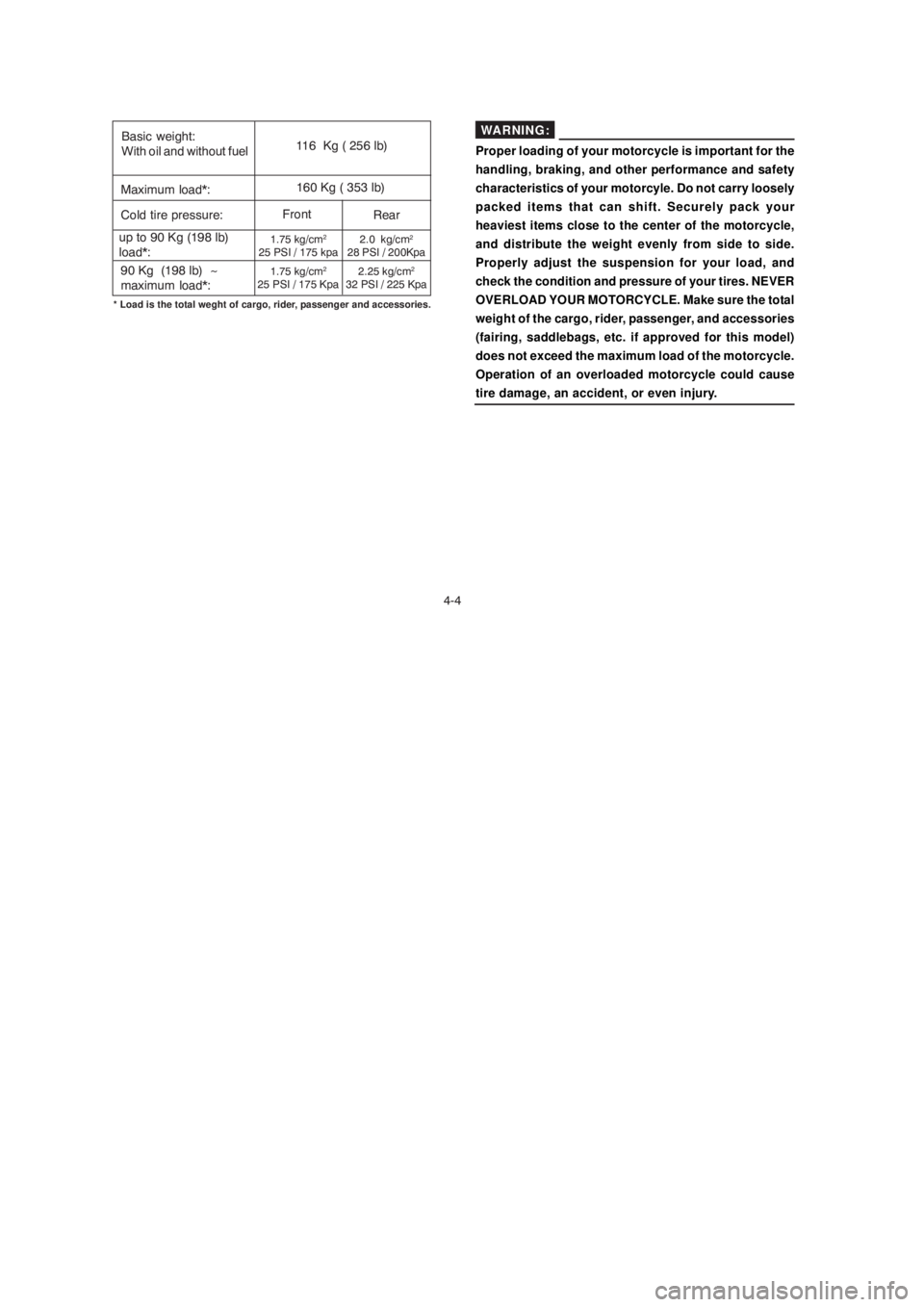
4-4
Basic weight:
With oil and without fuel
Maximum load*:
Cold tire pressure:
up to 90 Kg (198 lb)
load*:
90 Kg (198 lb) ~
maximum load*:116 Kg ( 256 lb)
160 Kg ( 353 lb)
Front
Rear
* Load is the total weght of cargo, rider, passenger and accessories.
1.75 kg/cm2
25 PSI / 175 kpa2.0 kg/cm
2
28 PSI / 200Kpa
1.75 kg/cm2
25 PSI / 175 Kpa2.25 kg/cm
2
32 PSI / 225 Kpa
Proper loading of your motorcycle is important for the
handling, braking, and other performance and safety
characteristics of your motorcyle. Do not carry loosely
packed items that can shift. Securely pack your
heaviest items close to the center of the motorcycle,
and distribute the weight evenly from side to side.
Properly adjust the suspension for your load, and
check the condition and pressure of your tires. NEVER
OVERLOAD YOUR MOTORCYCLE. Make sure the total
weight of the cargo, rider, passenger, and accessories
(fairing, saddlebags, etc. if approved for this model)
does not exceed the maximum load of the motorcycle.
Operation of an overloaded motorcycle could cause
tire damage, an accident, or even injury.
WARNING:
4-4
Basic weight:
With oil and without fuel
Maximum load*:
Cold tire pressure:
up to 90 Kg (198 lb)
load*:
90 Kg (198 lb) ~
maximum load*:116 Kg ( 256 lb)
160 Kg ( 353 lb)
Front
Rear
* Load is the total weght of cargo, rider, passenger and accessories.
1.75 kg/cm2
25 PSI / 175 kpa2.0 kg/cm
2
28 PSI / 200Kpa
1.75 kg/cm2
25 PSI / 175 Kpa2.25 kg/cm
2
32 PSI / 225 Kpa
Proper loading of your motorcycle is important for the
handling, braking, and other performance and safety
characteristics of your motorcyle. Do not carry loosely
packed items that can shift. Securely pack your
heaviest items close to the center of the motorcycle,
and distribute the weight evenly from side to side.
Properly adjust the suspension for your load, and
check the condition and pressure of your tires. NEVER
OVERLOAD YOUR MOTORCYCLE. Make sure the total
weight of the cargo, rider, passenger, and accessories
(fairing, saddlebags, etc. if approved for this model)
does not exceed the maximum load of the motorcycle.
Operation of an overloaded motorcycle could cause
tire damage, an accident, or even injury.
WARNING:
Page 33 of 83
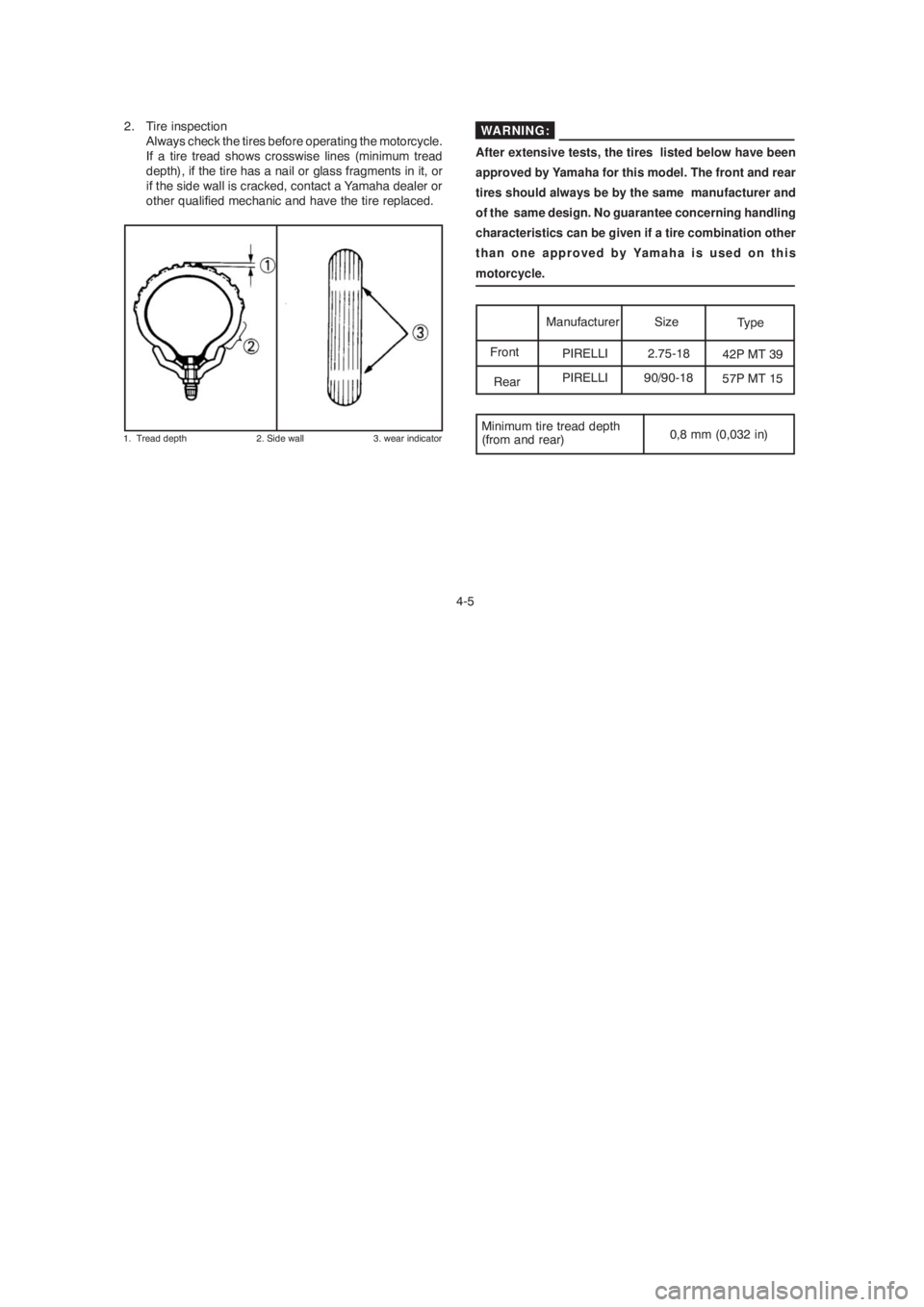
4-5 2. Tire inspection
Always check the tires before operating the motorcycle.
If a tire tread shows crosswise lines (minimum tread
depth), if the tire has a nail or glass fragments in it, or
if the side wall is cracked, contact a Yamaha dealer or
other qualified mechanic and have the tire replaced.
1. Tread depth 2. Side wall 3. wear indicator
After extensive tests, the tires listed below have been
approved by Yamaha for this model. The front and rear
tires should always be by the same manufacturer and
of the same design. No guarantee concerning handling
characteristics can be given if a tire combination other
than one approved by Yamaha is used on this
motorcycle.
Front
Rear
Size Manufacturer
Type
Minimum tire tread depth
(from and rear)0,8 mm (0,032 in) 2.75-18 PIRELLI
42P MT 39
90/90-18 PIRELLI
57P MT 15
WARNING:
4-5 2. Tire inspection
Always check the tires before operating the motorcycle.
If a tire tread shows crosswise lines (minimum tread
depth), if the tire has a nail or glass fragments in it, or
if the side wall is cracked, contact a Yamaha dealer or
other qualified mechanic and have the tire replaced.
1. Tread depth 2. Side wall 3. wear indicator
After extensive tests, the tires listed below have been
approved by Yamaha for this model. The front and rear
tires should always be by the same manufacturer and
of the same design. No guarantee concerning handling
characteristics can be given if a tire combination other
than one approved by Yamaha is used on this
motorcycle.
Front
Rear
Size Manufacturer
Type
Minimum tire tread depth
(from and rear)0,8 mm (0,032 in) 2.75-18 PIRELLI
42P MT 39
90/90-18 PIRELLI
57P MT 15
WARNING:
Page 34 of 83

4-6
1. It is dangerous to ride with a worn-out tire. When
the tire tread begin to show signs of wear, replace
the tire immediately. Brakes, tires and related wheel
parts should be left to a Yamaha dealer.
2. Patching a punctured tube is not recommended. If
it is absolutely necessary to do so, use great care
and replace the tube as soon as possible with a
good quality replacement.
Fitting/Fasteners
Alway check the tightness of chassis fittings and fasteners
before a ride. Use the chart on page 6-5 to find the correct
torque.
Switches
Check the operation of the starter switch, main switch,
ì Engine Stopî switch.
WARNING:Wheels
To ensure maximum performance, long service, and safe
operation, note the following:
1. Always inspect the wheels before a ride. Check for
cracks, bends, or warpage of the wheel; be sure the
spokes are tight and undamaged. If any abnormal
condition exists in a wheel, consult a Yamaha dealer or
other qualified mechanic. Do not attempt even small
repairs to the wheel. If a wheel is deformed or cracked,
it must be replaced.
2. Tires and wheels should be balanced whenever either
one is changed or replaced. Failure to have a wheel
balanced can result in poor performance, adverse
handling characteristics, and shortened tire life.
3. After installing a tire, ride conservatively to allow the
tire to seat itself on the rim properly. Failure to allow
proper seating may cause tire failure, resulting in
damage to the motorcycle and injury to the rider.
4-6
1. It is dangerous to ride with a worn-out tire. When
the tire tread begin to show signs of wear, replace
the tire immediately. Brakes, tires and related wheel
parts should be left to a Yamaha dealer.
2. Patching a punctured tube is not recommended. If
it is absolutely necessary to do so, use great care
and replace the tube as soon as possible with a
good quality replacement.
Fitting/Fasteners
Alway check the tightness of chassis fittings and fasteners
before a ride. Use the chart on page 6-5 to find the correct
torque.
Switches
Check the operation of the starter switch, main switch,
ì Engine Stopî switch.
WARNING:Wheels
To ensure maximum performance, long service, and safe
operation, note the following:
1. Always inspect the wheels before a ride. Check for
cracks, bends, or warpage of the wheel; be sure the
spokes are tight and undamaged. If any abnormal
condition exists in a wheel, consult a Yamaha dealer or
other qualified mechanic. Do not attempt even small
repairs to the wheel. If a wheel is deformed or cracked,
it must be replaced.
2. Tires and wheels should be balanced whenever either
one is changed or replaced. Failure to have a wheel
balanced can result in poor performance, adverse
handling characteristics, and shortened tire life.
3. After installing a tire, ride conservatively to allow the
tire to seat itself on the rim properly. Failure to allow
proper seating may cause tire failure, resulting in
damage to the motorcycle and injury to the rider.